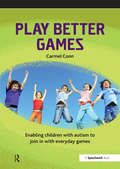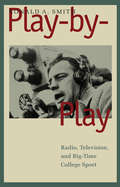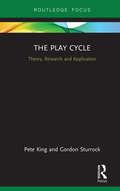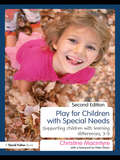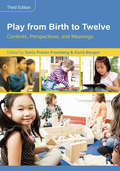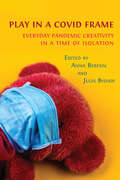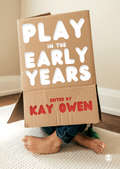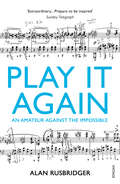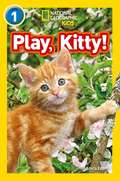- Table View
- List View
Play-based Learning in the Primary School
by Alice Hansen Mary BriggsPlay is an essential part of learning and development for children and is an increasingly important aspect of creative approaches to teaching and learning in primary education. This book demonstrates the value of play in all its different forms as a highly effective medium for teaching and learning across the curriculum. The authors explore how play can be used to increase engagement, motivation and fun in learning situations, examining the theoretical principles of play for learning, types of play for older children, planned and facilitating play-based learning, using thematic approaches when working with individuals, groups and whole classes, in addition to covering important teaching issues such as assessment, inclusion and transition out of primary education. This is recommended reading for students on primary initial teacher education courses including undergraduate (BEd, BA with QTS), postgraduate (PGCE, SCITT), and employment-based routes into teaching, and also for practicing teachers wishing to enhance their own teaching. Mary Briggs is Mathematics and Education tutor at the University of Warwick. Alice Hansen is an educational consultant who works within a number of educational settings and national bodies developing continuing professional development for teachers.
Play-based Learning in the Primary School (PDF)
by Alice Hansen Mary BriggsPlay is an essential part of learning and development for children and is an increasingly important aspect of creative approaches to teaching and learning in primary education. This book demonstrates the value of play in all its different forms as a highly effective medium for teaching and learning across the curriculum. The authors explore how play can be used to increase engagement, motivation and fun in learning situations, examining the theoretical principles of play for learning, types of play for older children, planned and facilitating play-based learning, using thematic approaches when working with individuals, groups and whole classes, in addition to covering important teaching issues such as assessment, inclusion and transition out of primary education. This is recommended reading for students on primary initial teacher education courses including undergraduate (BEd, BA with QTS), postgraduate (PGCE, SCITT), and employment-based routes into teaching, and also for practicing teachers wishing to enhance their own teaching. Mary Briggs is Mathematics and Education tutor at the University of Warwick. Alice Hansen is an educational consultant who works within a number of educational settings and national bodies developing continuing professional development for teachers.
Play Better Games: Enabling Children with Autism to Join in with Everyday Games
by Carmel ConnOrdinary games are an important vehicle for children's learning. They provide a powerful, naturally occurring learning environment that is physical, playful and fun. Playing games requires interpersonal skills in language, thought, social behavior, creativity, self-regulation and skilful use of the body. When children play games together they develop the following key capacities: •Cooperative behavior•Focused attention•Social understanding•Holding information in mind•Motor, spatial and sequential planning•Self-regulation, e.g impulse control, coping with excitement, controlled exertion•Collaborative behavior and negotiation•Self-expression and creativity.Games provide a social experience that is emotionally compelling, where children laugh and have fun and do not realise they are interacting, problem solving, negotiating and cooperating with each other.Play Better Games is designed to help practitioners and parents to think about what might prohibit their children from joining in with games and plan effective strategies for support. It will be of benefit to teachers, therapists, group works, play workers, midday supervisors and support workers, as well as to parents and siblings of children with autism.
Play-by-Play: Radio, Television, and Big-Time College Sport
by Ronald A. SmithThe phenomenal popularity of college athletics owes as much to media coverage of games as it does to drum-beating alumni and frantic undergraduates. Play-by-play broadcasts of big college games began in the 1920s via radio, a medium that left much to the listener's imagination and stoked interest in college football. After World War II, the rise of television brought with it network-NCAA deals that reeked of money and fostered bitter jealousies between have and have-not institutions. In Play-by-Play: Radio, Television, and Big-Time College Sport noted author and sports insider Ronald A. Smith examines the troubled relationship between higher education and the broadcasting industry, the effects of TV revenue on college athletics (notably football), and the odds of achieving meaningful reform.Beginning with the early days of radio, Smith describes the first bowl game broadcasts, the media image of Notre Dame and coach Knute Rockne, and the threat broadcasting seemed to pose to college football attendance. He explores the beginnings of television, the growth of networks, the NCAA decision to control football telecasts, the place of advertising, the role of TV announcers, and the threat of NCAA "Robin Hoods" and the College Football Association to NCAA television control. Taking readers behind the scenes, he explains the culture of the college athletic department and reveals the many ways in which broadcasting dollars make friends in the right places. Play-by-Play is an eye-opening look at the political infighting invariably produced by the deadly combination of university administrators, athletic czars, and huge revenue.
Play-by-Play: Radio, Television, and Big-Time College Sport
by Ronald A. SmithThe phenomenal popularity of college athletics owes as much to media coverage of games as it does to drum-beating alumni and frantic undergraduates. Play-by-play broadcasts of big college games began in the 1920s via radio, a medium that left much to the listener's imagination and stoked interest in college football. After World War II, the rise of television brought with it network-NCAA deals that reeked of money and fostered bitter jealousies between have and have-not institutions. In Play-by-Play: Radio, Television, and Big-Time College Sport noted author and sports insider Ronald A. Smith examines the troubled relationship between higher education and the broadcasting industry, the effects of TV revenue on college athletics (notably football), and the odds of achieving meaningful reform.Beginning with the early days of radio, Smith describes the first bowl game broadcasts, the media image of Notre Dame and coach Knute Rockne, and the threat broadcasting seemed to pose to college football attendance. He explores the beginnings of television, the growth of networks, the NCAA decision to control football telecasts, the place of advertising, the role of TV announcers, and the threat of NCAA "Robin Hoods" and the College Football Association to NCAA television control. Taking readers behind the scenes, he explains the culture of the college athletic department and reveals the many ways in which broadcasting dollars make friends in the right places. Play-by-Play is an eye-opening look at the political infighting invariably produced by the deadly combination of university administrators, athletic czars, and huge revenue.
Play Culture in a Changing World (UK Higher Education OUP Humanities & Social Sciences Education OUP)
by Marjatta KallialaThe cultural context in which children grow up has a powerful influence on the way they play. At a time of rapid change in post-industrial societies, childhood play is changing to reflect children’s experiences. Adults need to understand that children have their own play culture, which might be different from that of the adults’ own childhoods.Enlivened by the voices of young children engaged in contemporary play, this accessible book enables readers to re-evaluate the contribution of play in childhood. It explores the persistence of fundamental play themes alongside new variations on traditional themes, including:Competitions and gamesGames of chance and luckThe world of make-believe‘Dizzy play’This book helps adults to be reflective and to encourage children’s play by understanding and valuing their play culture. It is important reading for early years students and practitioners.
The Play Cycle: Theory, Research and Application (Advances in Playwork Research)
by Pete King Gordon SturrockTwenty years after Gordon Sturrock and the late Professor Perry Else’s 'Colorado Paper' introduced the Play Cycle, this theory of play now supports professional playwork practice, training and education. The Play Cycle: Theory, Research and Application is the first book of its kind to explain the theoretical concept of the Play Cycle, supported by recent research, and how it can be used as an observational method for anyone who works with children in a play context. The book investigates the understandings of the Play Cycle within the playwork field over the last 20 years, and its future application. It addresses each aspect of the Play Cycle (metalude, play cue, play return, play frame, loop and flow and annihilation) and combines the theoretical aspect of the Play Cycle with empirical research evidence. The book also provides an observational tool for people to observe and record play cycles. This book will appeal to playworkers, teachers, play therapists and professionals working in other contexts with children, such as hospitals and prisons. It will support practitioners and students in learning about play and provide lecturers and trainers with a new innovative teaching and training aide.
The Play Cycle: Theory, Research and Application (Advances in Playwork Research)
by Pete King Gordon SturrockTwenty years after Gordon Sturrock and the late Professor Perry Else’s 'Colorado Paper' introduced the Play Cycle, this theory of play now supports professional playwork practice, training and education. The Play Cycle: Theory, Research and Application is the first book of its kind to explain the theoretical concept of the Play Cycle, supported by recent research, and how it can be used as an observational method for anyone who works with children in a play context. The book investigates the understandings of the Play Cycle within the playwork field over the last 20 years, and its future application. It addresses each aspect of the Play Cycle (metalude, play cue, play return, play frame, loop and flow and annihilation) and combines the theoretical aspect of the Play Cycle with empirical research evidence. The book also provides an observational tool for people to observe and record play cycles. This book will appeal to playworkers, teachers, play therapists and professionals working in other contexts with children, such as hospitals and prisons. It will support practitioners and students in learning about play and provide lecturers and trainers with a new innovative teaching and training aide.
Play, Exploration and Learning: A Natural History of the Pre-school (Routledge Library Editions: Early Years)
by S. John Hutt Stephen Tyler Corinne Hutt Helen ChristophersonOriginally published in 1989, Play, Exploration and Learning was a valuable contribution to the evaluation of nursery practice in Britain at the time, this ‘natural history’ of the activities of children and caring adults presents a comparative study of four types of provision for the under-fives: nursery schools, nursery classes, playgroups and day nurseries. All four types of provision are seen as happy, busy, caring environments, but they vary greatly in terms of staffing levels, training and material provision. The authors look at the ‘play’ of three- to five-year-old children and the activities of the adults who care for them. They examine in detail children’s choices of materials and their use of them, with special attention given to the way language is used by both children and adults during play. They also describe adults’ expectations of the various provisions and the values of the activities pursued in them. Of special interest is the emphasis placed by adults upon fantasy play, and the often large discrepancy between expectation and practice. Also covered are the difference in the play activities of part-time and full-time nursery school children, and the transition from pre-school to first school. The book will still be of historical interest to pre-school practitioners, to developmental psychologists and to educational administrators.
Play, Exploration and Learning: A Natural History of the Pre-school (Routledge Library Editions: Early Years)
by S. John Hutt Stephen Tyler Corinne Hutt Helen ChristophersonOriginally published in 1989, Play, Exploration and Learning was a valuable contribution to the evaluation of nursery practice in Britain at the time, this ‘natural history’ of the activities of children and caring adults presents a comparative study of four types of provision for the under-fives: nursery schools, nursery classes, playgroups and day nurseries. All four types of provision are seen as happy, busy, caring environments, but they vary greatly in terms of staffing levels, training and material provision. The authors look at the ‘play’ of three- to five-year-old children and the activities of the adults who care for them. They examine in detail children’s choices of materials and their use of them, with special attention given to the way language is used by both children and adults during play. They also describe adults’ expectations of the various provisions and the values of the activities pursued in them. Of special interest is the emphasis placed by adults upon fantasy play, and the often large discrepancy between expectation and practice. Also covered are the difference in the play activities of part-time and full-time nursery school children, and the transition from pre-school to first school. The book will still be of historical interest to pre-school practitioners, to developmental psychologists and to educational administrators.
Play for Children with Special Needs: Supporting children with learning differences, 3-9
by Christine MacintyreThere are many more children with learning differences and difficulties in our schools today. Their needs are varied and complex and professionals must find appropriate ways to enhance their learning. The value of play is endorsed in policy initiatives including The Early Years Foundation Stage curriculum, so professionals can be reassured that ‘more time to play’ is in line with the latest thinking. Christine Macintyre emphasises the importance of creating an environment where children become confident, independent learners, increasingly able to use their imaginations, care for others and to take safe risks. This fully revised edition of Play for Children with Special Needs includes new research findings and explains their implications for practice. This book then enables those supporting children to: understand the benefits of play and how to adapt different scenarios to support children who do not find it easy to play observe children as they play so that any difficulties can be identified early analyse different play areas so that the different kinds of learning (intellectual, creative, motor, social and emotional) are appreciated. Play for Children with Special Needs, 2nd edition enables practitioners to appreciate the contribution that play makes to the education of all children, whether they have special needs or not. It is for parents, teachers, teaching assistants and nursery professionals as well as those who care for children at home.
Play for Children with Special Needs: Supporting children with learning differences, 3-9
by Christine MacintyreThere are many more children with learning differences and difficulties in our schools today. Their needs are varied and complex and professionals must find appropriate ways to enhance their learning. The value of play is endorsed in policy initiatives including The Early Years Foundation Stage curriculum, so professionals can be reassured that ‘more time to play’ is in line with the latest thinking. Christine Macintyre emphasises the importance of creating an environment where children become confident, independent learners, increasingly able to use their imaginations, care for others and to take safe risks. This fully revised edition of Play for Children with Special Needs includes new research findings and explains their implications for practice. This book then enables those supporting children to: understand the benefits of play and how to adapt different scenarios to support children who do not find it easy to play observe children as they play so that any difficulties can be identified early analyse different play areas so that the different kinds of learning (intellectual, creative, motor, social and emotional) are appreciated. Play for Children with Special Needs, 2nd edition enables practitioners to appreciate the contribution that play makes to the education of all children, whether they have special needs or not. It is for parents, teachers, teaching assistants and nursery professionals as well as those who care for children at home.
Play for Health Across the Lifespan: Stories from the Seven Ages of Play
by Julia Whitaker Alison TonkinPlay for Health Across the Lifespan uses case studies to explore the impact of play and creativity on health and wellbeing throughout the lifecycle. While play at the start of life influences future development, the authors show play also has a role in improving prospects for health and wellbeing in adulthood and later life. A relational approach to health and wellbeing emphasizes the dynamic, mutually influential relationship between individual development and the changing contexts of our lives. Our personal play history is one feature of this dynamic process, and this book explores how the experience of play throughout the life course sculpts and resculpts the shape of our lives: our physical health, our mental wellbeing, and our relationship to the people and the world around us. Storytelling has been used since the beginning of time to communicate important life lessons in an engaging way. Taking inspiration from Shakespeare’s ‘Seven Ages of Man’, the book uses a case-story approach to differentiate the stages of development and to present evidence for how play and playful experiences impact on health and wellbeing from birth to the end of life in the context of temporal and situational change. Each chapter in Play for Health Across the Lifespan introduces relevant evidence-based research on play and health, before presenting several narrative ‘case stories’, which illustrate the application of play theory and the neuroscience of play as they relate to each life stage. With contributions from specialists in health and education, community organizations and the creative and performing arts, this book will appeal to academics, students, and practitioners who are interested in exploring the role of play in addressing contemporary challenges to our physical, mental, and social health.
Play for Health Across the Lifespan: Stories from the Seven Ages of Play
by Julia Whitaker Alison TonkinPlay for Health Across the Lifespan uses case studies to explore the impact of play and creativity on health and wellbeing throughout the lifecycle. While play at the start of life influences future development, the authors show play also has a role in improving prospects for health and wellbeing in adulthood and later life. A relational approach to health and wellbeing emphasizes the dynamic, mutually influential relationship between individual development and the changing contexts of our lives. Our personal play history is one feature of this dynamic process, and this book explores how the experience of play throughout the life course sculpts and resculpts the shape of our lives: our physical health, our mental wellbeing, and our relationship to the people and the world around us. Storytelling has been used since the beginning of time to communicate important life lessons in an engaging way. Taking inspiration from Shakespeare’s ‘Seven Ages of Man’, the book uses a case-story approach to differentiate the stages of development and to present evidence for how play and playful experiences impact on health and wellbeing from birth to the end of life in the context of temporal and situational change. Each chapter in Play for Health Across the Lifespan introduces relevant evidence-based research on play and health, before presenting several narrative ‘case stories’, which illustrate the application of play theory and the neuroscience of play as they relate to each life stage. With contributions from specialists in health and education, community organizations and the creative and performing arts, this book will appeal to academics, students, and practitioners who are interested in exploring the role of play in addressing contemporary challenges to our physical, mental, and social health.
Play from Birth to Twelve: Contexts, Perspectives, and Meanings
by Doris Pronin Fromberg and Doris BergenIn light of recent standards-based and testing movements, the issue of play in child development has taken on increased meaning for educational professionals and social scientists. This third edition of Play From Birth to Twelve offers comprehensive coverage of what we now know about play and its guiding principles, dynamics, and importance in early learning. These up-to-date essays, written by some of the most distinguished experts in the field, help educators, psychologists, anthropologists, parents, health service personnel, and students explore a variety of theoretical and practical ideas, such as: all aspects of play, including historical and diverse perspectives as well as new approaches not yet covered in the literature how teachers in various classroom situations set up and guide play to facilitate learning how play is affected by societal violence, media reportage, technological innovations, and other contemporary issues play and imagination within the current scope of educational policies, childrearing methods, educational variations, cultural differences, and intellectual diversity New chapters in the third edition of Play From Birth to Twelve cover current and projected future developments in the field of play, such as executive function, neuroscience, autism, play in museums, "small world" play, global issues, media, and technology. The book also suggests ways to support children’s play across different environments at home, in communities, and within various institutional settings.
Play from Birth to Twelve: Contexts, Perspectives, and Meanings
by Doris Pronin FrombergFirst published in 1998. Play is pervasive, infusing human activity throughout the life span. In particular, it serves to characterize childhood, the period from birth to age twelve. Within the past twenty years, many additions to the knowledge base on childhood play have been published in popular and scholarly literature. This book assembles and integrates this information, discusses disparate and diverse components, highlights the underlying dynamic processes of play, and provides a forum from which new questions may emerge and new methods of inquiry may develop. The place of new technologies and the future of play in the context of contemporary society also are discussed.
Play from Birth to Twelve: Contexts, Perspectives, and Meanings
by Doris Pronin Fromberg Doris BergenIn light of recent standards-based and testing movements, the issue of play in child development has taken on increased meaning for educational professionals and social scientists. This third edition of Play From Birth to Twelve offers comprehensive coverage of what we now know about play and its guiding principles, dynamics, and importance in early learning. These up-to-date essays, written by some of the most distinguished experts in the field, help educators, psychologists, anthropologists, parents, health service personnel, and students explore a variety of theoretical and practical ideas, such as: all aspects of play, including historical and diverse perspectives as well as new approaches not yet covered in the literature how teachers in various classroom situations set up and guide play to facilitate learning how play is affected by societal violence, media reportage, technological innovations, and other contemporary issues play and imagination within the current scope of educational policies, childrearing methods, educational variations, cultural differences, and intellectual diversity New chapters in the third edition of Play From Birth to Twelve cover current and projected future developments in the field of play, such as executive function, neuroscience, autism, play in museums, "small world" play, global issues, media, and technology. The book also suggests ways to support children’s play across different environments at home, in communities, and within various institutional settings.
Play from Birth to Twelve: Contexts, Perspectives, and Meanings
by Doris Pronin Fromberg Doris BergenFirst published in 1998. Play is pervasive, infusing human activity throughout the life span. In particular, it serves to characterize childhood, the period from birth to age twelve. Within the past twenty years, many additions to the knowledge base on childhood play have been published in popular and scholarly literature. This book assembles and integrates this information, discusses disparate and diverse components, highlights the underlying dynamic processes of play, and provides a forum from which new questions may emerge and new methods of inquiry may develop. The place of new technologies and the future of play in the context of contemporary society also are discussed.
Play in a Covid Frame Everyday Pandemic Creativity in a Time of Isolation: (pdf)
by Anna Beresin Julia BishopDuring the international coronavirus lockdowns of 2020–2021, millions of children, youth, and adults found their usual play areas out of bounds and their friends out of reach. How did the pandemic restrict everyday play and how did the pandemic offer new spaces and new content? This unique collection of essays documents the ways in which communities around the world harnessed play within the limiting frame of Covid-19. Folklorists Anna Beresin and Julia Bishop adopt a multidisciplinary approach to this phenomenon, bringing together the insights of a geographically and demographically diverse range of scholars, practitioners, and community activists. The book begins with a focus on social and physical landscapes before moving onto more intimate portraits of play among the old and young, including coronavirus-themed games and novel toy inventions. Finally, the co-authors explore the creative shifts observed in frames of play, ranging from Zoom screens to street walls. This singular chronicle of coronavirus play will be of interest to researchers and students of developmental psychology, childhood studies, education, playwork, sociology, anthropology and folklore, as well as to toy, museum, and landscape designers. This book will also be of help to parents, professional organizations, educators, and urban planners, with a postscript of concrete suggestions advocating for the essential role of play in a post-pandemic world.
Play in the Early Years
by Kay OwenPlay in the Early Years provides an accessible overview of key concepts, debates and approaches to children’s Play. This book: · Considers play from a variety of perspectives · Offers expert insights into theory and research in each area · Encourages the reader to critically reflect on both theory and practice With features including key terms, case studies, reflective questions, spotlights on research and an accompanying glossary, this text is perfect for everyone who is interested in Play - from those just starting undergraduate degrees through to those with more advanced knowledge or experience.
Play in the Early Years
by Kay OwenPlay in the Early Years provides an accessible overview of key concepts, debates and approaches to children’s Play. This book: · Considers play from a variety of perspectives · Offers expert insights into theory and research in each area · Encourages the reader to critically reflect on both theory and practice With features including key terms, case studies, reflective questions, spotlights on research and an accompanying glossary, this text is perfect for everyone who is interested in Play - from those just starting undergraduate degrees through to those with more advanced knowledge or experience.
Play in the Early Years
Play in the Early Years provides an accessible overview of key concepts, debates and approaches to children’s Play. This book: · Considers play from a variety of perspectives · Offers expert insights into theory and research in each area · Encourages the reader to critically reflect on both theory and practice With features including key terms, case studies, reflective questions, spotlights on research and an accompanying glossary, this text is perfect for everyone who is interested in Play - from those just starting undergraduate degrees through to those with more advanced knowledge or experience.
Play in the Early Years (Second Edition) (PDF)
by Marilyn FleerIn this second edition of Play in the Early Years, Marilyn Fleer provides a comprehensive introduction to pedagogy and play in early years education settings. Drawing on classical and contemporary theories, this text examines social, cultural and institutional approaches to play, and explores a range of strategies for successfully integrating play into early years and primary classrooms. Thoroughly revised to include the latest methods and research into early years development and learning, this latest edition features new material on intentional teaching, play as learning, digital play, and discipline-specific content including STEM, arts and sustainability. Two new chapters discuss post-structuralist and cultural-historical conceptions of play, and extended practical examples link pedagogical practice to the Early Years Learning Framework and the Australian Curriculum. The text is pedagogically rich, with classroom vignettes and photographs designed to help students connect theory to practice, while reflection questions and research activities encourage in-depth reflection and extend learning. Each chapter is supported by additional content on the comprehensive companion website, which provides links to videos, readings and supplementary activities. Freshly presented in a new full-colour layout and written in an accessible and engaging style, Play in the Early Years remains an essential resource for pre-service students and practitioners alike.
Play It Again: An Amateur Against The Impossible
by Alan RusbridgerIn 2010, Alan Rusbridger, the editor of the Guardian, set himself an almost impossible task: to learn, in the space of a year, Chopin’s Ballade No. 1 – a piece that inspires dread in many professional pianists. His timing could have been better. The next twelve months were to witness the Arab Spring, the Japanese tsunami, the English riots, and the Guardian’s breaking of both WikiLeaks and the News of the World hacking scandal. In the midst of this he carved out twenty minutes’ practice a day – even if that meant practising in a Libyan hotel in the middle of a revolution as well as gaining insights and advice from an array of legendary pianists, theorists, historians and neuroscientists, and even occasionally from secretaries of state. But was he able to play the piece in time?
Play, Kitty!: Level 1 (PDF)
by Shira Evans National Geographic Kids StaffNational Geographic Primary Readers pair magnificent National Geographic photographs with engaging text by skilled authors to help your child learn to read. Developed by education experts, this series of books for beginner readers is spread across four levels: Early Reader, Becoming Fluent, Becoming Independent and Independent Reader. Pounce! Follow a little kitten through its day to learn all about young cats. Told in simple yet lively text, Play, Kitty! will enchant children who are just beginning their reading journey. Level 1: Early Reader books contain simple sentences and are just right for kids who can decode with ease and are beginning to read fluently. They are ideal for readers of Yellow and Blue book bands for guided reading.


